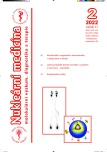-
Medical journals
- Career
Lymphoscintigraphy in diabetic – case report
Authors: Otto Lang 1,2,5; Věra Prýmková 3; Barbora Daňhová 4
Authors‘ workplace: Klinika nukleární medicíny, 3. LF a FN Královské Vinohrady, Praha 10 1; Oddělení nukleární medicíny 2; Interní oddělení 3; Oddělení rehabilitace, ON Příbram, a. s. 4; Odděllení nukleární medicíny, PMCD s. r. o., Praha 6, ČR 5
Published in: NuklMed 2022;11:32-35
Category: Casuistry
Overview
Introduction: Diabetic microangipathy is one of the most serious complication of diabetes mellitus. More factors take part in this issue, the most important is neuropathy and increased pressure in the venous system as a result of venous perforators or valves insufficiency of deep venous system in postflebitic syndrome. High perfusion microangopathy is a result of these changes. It is characterized by increased capillary permeability and increased proteins and liquids filtration into the interstitium. The final result is edema. Skin and tissues necrosis due to nutritious capillaries compression and worsened gases and substances diffusion through the edema can be a result. Our case report shows the use of lymphoscintigraphy for the assessment of interstitium volume load and the effect of lymphodrainage to the patient difficulties.
Case report: 73-y-old female was sent to our department for the assessment of lymphatic system of lower extremities. She had a diabetes mellitus type 2 for 8 years, she was treated with a diet and oral antidiabetics. She was obese, had a hypertension and early stage of renal insufficiency. Diabetic polyneuropathy was also diagnosed. She felt a feet discomfort with a feeling of stiffness and heaviness; no edemas or skin defect was present. Lymphoscintigraphy of the lower extremities was performed. It confirmed significantly increased lymphatic transport in both legs, namely after walk load, with an appearance of skin collaterals. Manual and device lymphodrainage was indicated, 6 application each. Patient difficulties disappeared afterwards.
Conclusion: Our case report illustrates the significance of lymphoscintigraphy for the detection of subclinical edema of lower extremities and the effectivity of lymphodrainage to the patient difficulties. Believe this procedure can contribute to the timely diagnosis of the microcirculation disorders. Thus, it can help to prevent serious complication in the form of development of diabetic foot syndrome.
Keywords:
diabetic foot syndrome – polyneuropathy – lymphoscintigraphy
Sources
- Boulton AJ, Vileikyte L, Ragnarson-Tennvall G et al. The global burden of diabetic foot disease. Lancet 2005;366 : 1719-1724
- Apelqvist J. Diagnostics and treatment of the diabetic foot. Endocrine 2012;41 : 384-397
- Boyko EJ, Ahtoni JH, Stensel V et al. A prospecticve study for risk factors for diabetic ulcer. The Seattle Diabetic Foot Study. Diabetes Care 1999;22 : 1036–1042
- Tesfaye S, Boulton AJM, Dyck PJ et al. Diabetic neuropathies: update on definitions, diagnostic criteria, estimation of severity, and treatments. Diabetes Care 2010;33 : 2285–2293
- Apelqvist J, Larson J. What is the most effective way to reduce incidence of amputation in the diabetic foot? Diabetes Metab. Res. Rev. 2000;16(S1):75–83
- Krishnan S, Nash F, Baker N et al. Reduction in diabetic amputations over 11 years in a defined U.K. population: benefits of multidisciplinary team work and continuous prospective audit. Diabetes Care 2008;31 : 99–101
- Lin CT, Ou KW, Chang SC. Diabetic Foot Ulcers Combination with Lower Limb Lymphedema Treated by Staged Charles Procedure: Case Report and Literature Review. Pak J Med Sci 2013;29 : 1062-1064.
- Národní radiologické standardy. Nukleární medicína. Dostupné na https://www.mzcr.cz/wp-content/uploads/wepub/11347/36103/V%C4%9Bstn%C3%ADk%20MZ%20%C4%8CR%202-2016.pdf
- Kubinyi J, Knotková V, Hrbáč J et al. Lymfoscintigrafie. NuklMed 2018;7(S2):1-4
- Richard JL, Lavigne JP, Sotto A. Diabetes and foot infection: more than double trouble. Diabetes Metab Res Rev 2012;28(S1): 46–53
- Jörneskog G. Why critical limb ischemia criteria are not applicable to diabetic foot and what the consequences are. Scandinavian Journal of Surgery 2012;101 : 114–118
- Belcaro G, Laurora G, Cesarone MR et al. Microcirculation in high perfusion mecroangopathy. J Cardiovasc Surg 1995;36 : 393-398
- Liao S, von der Weid PY. Lymphatic system: An active pathway for immune protection. Seminars in Cell & Developmental Biology 2015;38 : 83–89
- Partsch H. Assessment of abnormal lymph drainage for the diagnosis of lymphedema by isotopic lymphangiography and by indirect lymphography. Clinics in Dermatology 1995;13 : 445-450
Labels
Nuclear medicine Radiodiagnostics Radiotherapy
Article was published inNuclear Medicine

2022 Issue 2-
All articles in this issue
- Editorial
- Multimodal magnetic nanomaterials for diagnostics and therapy
- Lymphoscintigraphy in diabetic – case report
- Klinika nukleární medicíny 3. LF UK a FN Královské Vinohrady v Praze
- Historický kvíz
- Sonda do historie
- 10. Konference radiologické fyziky, Přerov
- Spolupráce na přípravě nejslibnějšího zářiče alfa pro léčbu nádorových onemocnění
- Slavnostní přednáška prof. Ing. Ondřeje Lebedy, Ph.D.
- Nuclear Medicine
- Journal archive
- Current issue
- Online only
- About the journal
Most read in this issue- Lymphoscintigraphy in diabetic – case report
- Klinika nukleární medicíny 3. LF UK a FN Královské Vinohrady v Praze
- Multimodal magnetic nanomaterials for diagnostics and therapy
- 10. Konference radiologické fyziky, Přerov
Login#ADS_BOTTOM_SCRIPTS#Forgotten passwordEnter the email address that you registered with. We will send you instructions on how to set a new password.
- Career

